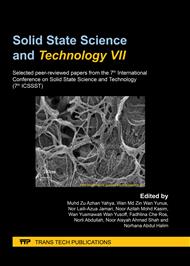[1]
S. Mustapha, H. Chandar, Z.Z. Abidin, R. Saghravani, M.Y. Harun, Production of semi-refined carrageenan from Eucheuma cotonii, Journal of Scientific & Industrial Research 70 (2011) 865-870.
Google Scholar
[2]
J. Necas, L. Bartosikova, Carrageenan: a review, Veterinarni medicina 58(4) (2013) 187-205.
Google Scholar
[3]
T. Karbowiak, H. Hervet, L. Léger, D. Champion, F. Debeaufort, A. Voilley, Effect of plasticizers (water and glycerol) on the diffusion of a small molecule in iota-carrageenan biopolymer films for edible coating application, Biomacromolecules 7(6) (2006) 2011-2019.
DOI: 10.1021/bm060179r
Google Scholar
[4]
J. Liu, X. Zhan, J. Wan, Y. Wang, C. Wang, Review for carrageenan-based pharmaceutical biomaterials: favourable physical features versus adverse biological effects, Carbohydrate polymers 121 (2015) 27-36.
DOI: 10.1016/j.carbpol.2014.11.063
Google Scholar
[5]
S.M. Mihaila, A.K. Gaharwar, R.L. Reis, A.P. Marques, M.E. Gomes, A. Khademhosseini, Photocrosslinkable kappa‐carrageenan hydrogels for tissue engineering applications, Advanced healthcare materials 2(6) (2013) 895-907.
DOI: 10.1002/adhm.201200317
Google Scholar
[6]
E.G. Popa, M.E. Gomes, R.L. Reis, Cell delivery systems using alginate–carrageenan hydrogel beads and fibers for regenerative medicine applications, Biomacromolecules 12(11) (2011) 3952-3961.
DOI: 10.1021/bm200965x
Google Scholar
[7]
A. Akesowan, Effect of combined stabilizers containing Konjac flour and κ-carrageenan on ice cream, AU J.T. 12(2) (2008) 81-85.
Google Scholar
[8]
K. Prasad, Y. Kaneko, J.I. Kadokawa, Novel gelling systems of κ‐, ι‐and λ‐carrageenans and their composite gels with cellulose using ionic liquid, Macromolecular bioscience 9(4) (2009) 376-382.
DOI: 10.1002/mabi.200800179
Google Scholar
[9]
L. Du, Y. Lu, L. Geonzon, J. Xie, S. Matsukawa, Rheological properties and interactions between polysaccharides in mixed carrageenan solutions, Journal of Biorheology 30(1) (2016) 13-18.
DOI: 10.17106/jbr.30.13
Google Scholar
[10]
S. Kodama, J. Kuwabara, X. Jiang, I. Fukushima, T. Kanbara, Effect of Purification Solvent on Polymer Impurities and Device Performance, ACS Applied Polymer Materials 1(8) (2019) 2083-2088.
DOI: 10.1021/acsapm.9b00385
Google Scholar
[11]
J. Jorda, P. Marechal, L. Rigal, P.Y. Pontalier, Biopolymer purification by ultrafiltration, Desalination 148(1-3) (2002) 187-191.
DOI: 10.1016/s0011-9164(02)00696-3
Google Scholar
[12]
T.N.T.V. Bui, Structure, Rheological Properties and Connectivity of Gels Formed by Carrageenan Extracted from Different Red Algae Species, Doctoral dissertation, Universite du Maine, (2019).
Google Scholar
[13]
N.A.A. Ghani, R. Othaman, A. Ahmad, F.H. Anuar, N.H. Hassan, Impact of purification on iota carrageenan as solid polymer electrolyte, Arabian journal of chemistry 12(3) (2019) 370-376.
DOI: 10.1016/j.arabjc.2018.06.008
Google Scholar
[14]
V.L. Campo, D.F. Kawano, D.B. da Silva Jr, I. Carvalho, Carrageenans: Biological properties, chemical modifications and structural analysis–A review, Carbohydrate polymers 77(2) (2009) 167-180.
DOI: 10.1016/j.carbpol.2009.01.020
Google Scholar
[15]
P. Volery, R. Besson, C. Schaffer-Lequart, Characterization of commercial carrageenans by Fourier transform infrared spectroscopy using single-reflection attenuated total reflection, Journal of agricultural and food chemistry 52(25) (2004) 7457-7463.
DOI: 10.1021/jf040229o
Google Scholar
[16]
I.J. Shamsudin, A. Ahmad, N.H. Hassan, H. Kaddami, Biopolymer electrolytes based on carboxymethyl ҡ-carrageenan and imidazolium ionic liquid, Ionics 22(6) (2016) 841-851.
DOI: 10.1007/s11581-015-1598-5
Google Scholar
[17]
G. Rytwo, R. Zakai, B. Wicklein, The use of ATR-FTIR spectroscopy for quantification of adsorbed compounds, Journal of Spectroscopy 2015 (2015) 1-8.
DOI: 10.1155/2015/727595
Google Scholar
[18]
D.S. Achilias, A. Giannoulis, G.Z. Papageorgiou, Recycling of polymers from plastic packaging materials using the dissolution–reprecipitation technique, Polymer Bulletin 63(3) (2009) 449-465.
DOI: 10.1007/s00289-009-0104-5
Google Scholar
[19]
I.U.M. Roldán, A.T. Mitsuhara, J.P.M. Desajacomo, L.E. de Oliveira, V.C. Gelli, R. Monti, F. Masarin, Chemical, structural, and ultrastructural analysis of waste from the carrageenan and sugar-bioethanol processes for future bioenergy generation, Biomass and Bioenergy 107(2017) 233-243.
DOI: 10.1016/j.biombioe.2017.10.008
Google Scholar


